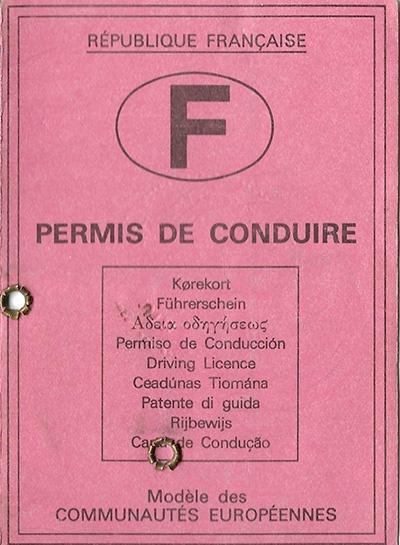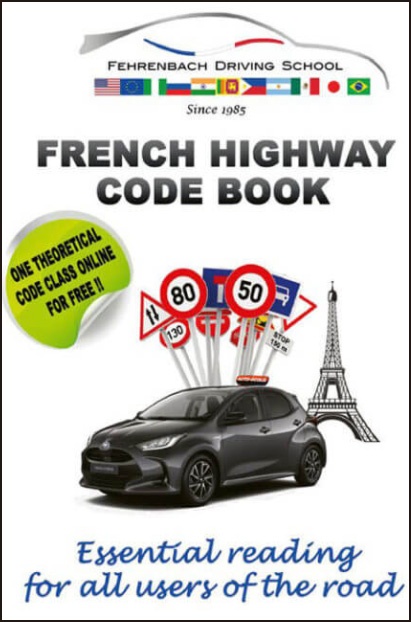
French Driver’s Licenses used to be pink and made of paper! Since Sept 2013 modernization has come to newly obtained licenses which are now credit card sized plastic cards with a chip. All pink paper licenses are to be replaced gradually before 2033. The end of an era.
Driving in France: what you need to know
This article covers driving in France: paperwork, insurance, and how to obtain it. Buying a car. In case of accident. Items you are required to have in the car.
If you are British, you may want to follow this link for regulations post-Brexit.
DRIVER’S LICENSE:
Generally speaking (because there are of course exceptions, this IS France) if you are in France for over a year and your driver’s license is not European, French law requires you to have valid French driving papers for driving in France. This one year period starts on the date of your first carte de séjour. Etudiant status is one of the exceptions; as a student you can drive with your foreign license for the duration of your studies. Some US states and other countries allow an exchange of licenses, other states and countries do not and you’ll be required to pass the French exam to obtain the French license. Keep in mind an exchange must be done within the one year grace period, failure to exchange in time will mean having to take the test in order to obtain a French license. Depending on your nationality, you must make the request within a certain period. If you meet the conditions, you will be issued a French driving license. The conditions include that the driver’s license being exchanged be valid, that it comes from the state or country in which you last resided, is from a state or country which has a reciprocity agreement with France and accompanied by a French certified translation. US States with a reciprocity agreement as of 05/2020 are: Delaware – Maryland – Ohio – Pennsylvania – Virginia – South Carolina- Massachusetts – New Hampshire – Illinois – Iowa – Michigan – Wisconsin – Arkansas – Oklahoma – Texas – Colorado – Florida – Connecticut. For other countries see this list. The request for exchange is made online on the ANTS website. (gotta love that acronym)
If you cannot exchange your existing license it is not necessary to go through a driving school to obtain a French license. You may take both the written exam and the driving exam on your own, in French or with a translator, and do the preparation on your own as well for example at the BPI (Bibliothèque publique d’information at the Pompidou Center). A school however does do all the paperwork and scheduling which can facilitate the process and reduce the wait for a test date. It is also not a bad idea to do at least a few hours of driving practice with a school before taking the test. They’ll give you the insider tips on how to pass and take you through the actual circuit. Not to mention teach you the rules of the French road and road signs which is very helpful.
If you obtain a new license by taking the exam, you will be considered a jeune conducteur and receive a restricted license even if you have had years of driving experience elsewhere. This means that you will have only 6 points instead of 12 for the first 3 years. And you will have to put the scarlet letter A on the back of your car, meaning that you must drive slower than the speed limit on roads outside of cities.
The plus side is that French driver’s licenses are valid for 15 years (as of Sept 2013) and can be renewed by simple administrative formality without retesting.
To check on the number of points left on your license: check with the prefecture either by mail or in person. Those who have the newest licenses with chips and a confidential code can use the online service Telepoints. Good news for 2024 : you’ll no longer lose points on your license for slight speeding tickets of up to 5Km/hour over the speed limit (but not so fast! the fine, from €68-€135 remains in place).

The Fehrenbach International School of Driving offers driving in France courses in English. Fehrenbach also offers a DVD and code book for learning on your own.
For information on exchanging your driver’s license for a French one, visit the site of the Préfecture de Police. Scroll down to the section OBTENTION D’UN TITRE DE CONDUITE, then part C. (Site in French).
BUYING A CAR:
The seller of a used car must provide:
Carte grise = registration (if the seller does not have this, do not buy the car, you won’t be able to put the car in your name without it). The seller, once he has received your money, will write « Vendu le » with the date and time of the sale on the carte grise, then sign it before giving it to you.
Déclaration de cession d’un véhicule – Declaration of sale. This is signed by both parties but kept by the seller so he can prove that the car is no longer his
Certificat de non-gage – proves that there are no legal liens or outstanding parking tickets on the car.
Certificat de contrôle technique – proves that car passed vehicle inspection
Once you have completed the sale take all the documents to your local préfecture and get your new carte grise. You have one month from the day you bought the car to get it registered in your name. Don’t forget to get at least minimal insurance too.
Carte Grise: Must be kept in the car at all times. The cost depends on how many horsepower (chevaux) your car has. As of 2009, cars in France now have license plate numbers for life (regardless of who owns it), so you won’t have to get a new number plate if the car already has the new license plate (white background, black letters like the one shown here). You still need to get an updated carte grise to show the change in ownership.

Contrôle Technique (CT): This is a vehicle inspection that must be done every two years for most cars when driving in France. Sellers must do the CT within 6 months of selling a car. There are two listings on the CT: contre-visite means that there are problems that need to be fixed within 2 months or the car cannot be driven legally; and the second heading lists other problems that should be fixed, but aren’t required by law.
Assurance responsabilité civile: Car insurance is required for driving in France. You must have at least liability coverage. You will receive a small pocket-like sticker to put on your windshield, in which you must display your green proof of insurance. In addition, you should keep the larger proof of insurance paper with your carte grise, as the police will ask for them if they stop you.
Yellow Vest/Red Triangle/Alcohol test: These items must be kept in the car and readily accessible. A yellow safety visibility vest must be worn in case of emergencies. You must have it on when you exit the vehicle so keep it in the vehicle not in the trunk. In addition, you must have a red reflective triangle that needs to be put at least 30 meters behind your stopped car to warn oncoming traffic. And most recently it is obligatory to have an blood alcohol tester in the vehicle. You could face a fine if you do not have these items in your car.

Accident report IN ENGLISH:
If you have an accident with your car in France, you’re probably going to need to fill out an accident report for the insurance company. In French it’s called a « constat d’accident ». Your insurance company will provide you one in French to keep in your glove box. Here is one in English to guide you through filling out the form and drawing the accident diagram. It’s nice to have this English version handy in the glove box too, in case when an accident happens you are not calm, cool and thinking straight – in French.
 Traffic report
Traffic report
You can get an up to the minute traffic report for the Paris area on http://www.sytadin.fr/. Other larger cities also have their own sites which you can find via Bison Futé. (Why on Earth is the traffic reporting system called « Bison Futé »? Learn all about the French driver’s favorite character in our article.
BONNE ROUTE!

